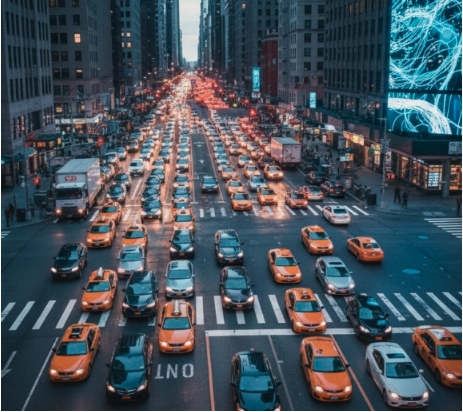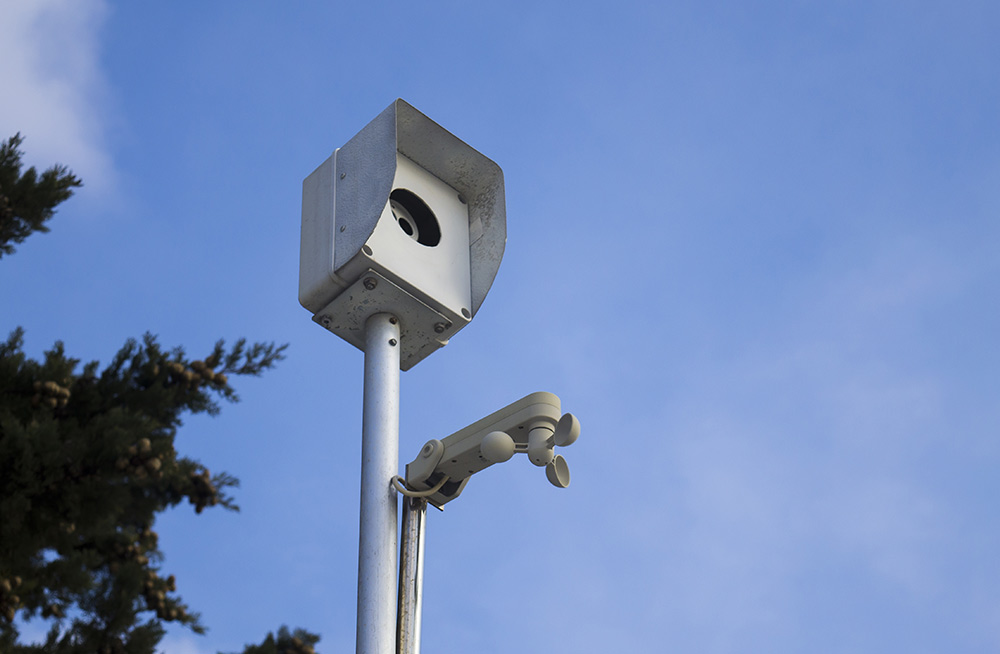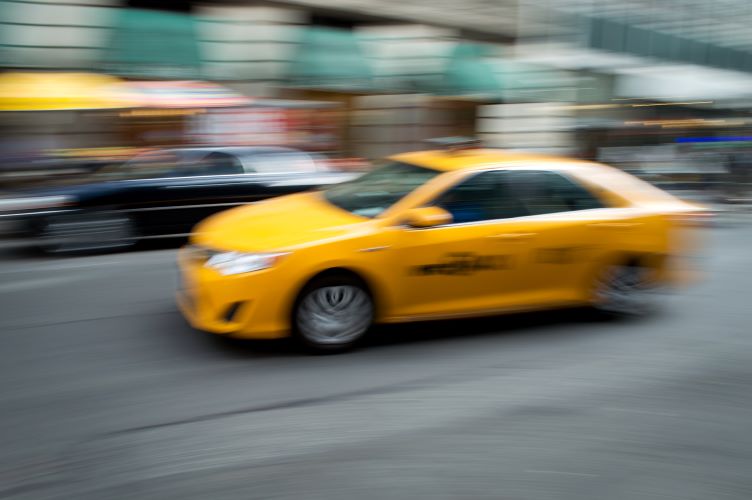If you ever received a NYC traffic ticket while driving in New York City, you probably wished you had a heads up to avoid certain areas that are prone to tickets being issued. This article highlights the three most common areas we see clients come to us with tickets for common infractions.
The three most common areas where drivers receive moving violation tickets in NYC are:
- Manhattan-side entrances/exits of the Midtown Tunnel,
- Intersection of Atlantic Avenue and Flatbush Avenue in Brooklyn, and
- Entire length of the Cross Bronx Expressway (I-95).
These locations are notorious for a perfect storm of factors: high traffic volume, confusing lane changes, and aggressive enforcement tactics, often leading to tickets for everything from illegal turns to NYC speeding ticket infractions. Understanding why these areas are traps is the first step toward beating the system.
Why These 3 Areas Are NYC’s Biggest Ticket Traps
Navigating New York City is a test of patience and skill, but some locations are intentionally designed (or frequently patrolled) to maximize enforcement revenue. Our firm’s analysis of violation data and client case history consistently highlights these three major hotspots.
1. Midtown Tunnel (Manhattan Exits/Entrances)
The area around the Queens-Midtown Tunnel (connecting Queens to Manhattan’s East Side) is a perennial ticket goldmine, particularly for violations like improper lane change, running lights, and failure to yield.
Famous “Tunnel Transition” Trap
The main issue here is the chaotic merging and lane-shifting required near the tunnel’s portals, especially on the Manhattan side near 37th Street and 2nd Avenue.
The Illegal Turn/Lane Change: As drivers navigate the rush to enter or exit the tunnel, many make slight maneuvers over double white or solid yellow lines to gain an advantage. Traffic enforcement agents (TEAs) and NYPD officers position themselves to observe these slight infractions, knowing that drivers’ focus is already split between tunnel traffic and pedestrian activity.
An illegal lane change here is one of the most common and easily defensible traffic violations, but it carries a hefty fine and points.
Failure to Signal/Yield: The abrupt transition from high-speed tunnel traffic to Manhattan street grid traffic often results in drivers forgetting to signal or failing to yield to buses or merging traffic.
This is a behavioral trap; tunnel relief causes many drivers to relax too quickly, leading to easily observed infractions.
2. Atlantic Avenue & Flatbush Avenue (Brooklyn)
This Downtown Brooklyn intersection is a dense, multi-directional crossing that serves as a nexus for the Barclays Center, major subway lines, the Long Island Rail Road (LIRR), and several highly utilized commercial avenues. It is the number one spot for NYC red light tickets issued by camera.
“Gridlock and Camera” Trap
This area generates a high volume of traffic violation tickets due to complex signal timing and heavily utilized red light cameras.
Left-Turn Penalty: If you are trying to make a left turn onto Flatbush or Atlantic during heavy traffic, it is very easy to enter the intersection legally but then be caught in the “box” when the light changes. Being caught blocking traffic (gridlock) is a violation aggressively enforced by TEAs on the ground.
Automated Red Light Cameras: This intersection is heavily monitored by automated camera systems. Unlike a police officer who can exercise discretion, the camera is an impartial witness.
Many drivers receive NYC red light tickets because they fail to anticipate the quick change in traffic flow or try to “beat the yellow.” The moment the light turns red, the camera flashes, and an expensive citation is mailed to your address.
3. The Cross Bronx Expressway (I-95)
While this is not a single point, the entire 8-mile stretch of I-95 through the Bronx is the city’s number one hotspot for genuine NYC speeding ticket infractions and equipment violations.
“Speed and Frustration” Trap
The Cross Bronx is notorious for two things: extreme congestion and periods of sudden open roadway. This combination makes it a perfect enforcement environment.
The Speed-Up Zone: After drivers endure stop-and-go traffic that can last for hours, the expressway often opens up briefly. Drivers, naturally frustrated, overcompensate and accelerate well past the posted speed limit (often 50 mph).
State Troopers and NYPD Highway Patrol units frequently set up speed traps near the exits for Major Deegan Expressway (I-87) and Bruckner Expressway (I-278), waiting for drivers to hit their breaking point.
The Commercial Violation Audit: Due to the heavy volume of tractor-trailers and commercial vehicles, this section is a frequent focus for commercial vehicle inspections.
If you are operating a commercial vehicle, expect frequent checks for weight, registration, and equipment infractions like faulty lights or worn tires, all of which lead to mandatory court appearances and steep fines.
Defense Strategies for Avoiding and Fighting NYC Traffic Violations
Avoiding the above hotspots is the easiest solution, but when a ticket is inevitable, your defense strategy must be sharp. This is where an experienced speeding ticket lawyer can make a critical difference, moving your intent from informational (“Where are the traps?”) to transactional (“How do I fix this?”).

Navigational Intent: Real-World Solutions
Many drivers search for solutions immediately after receiving a ticket. Here is a quick guide to addressing common ticket types:
| Violation Type | Immediate Action | Lawyer Defense Focus |
| Speeding Ticket | Plead Not Guilty. Never explain or admit guilt to the officer. | Radar/LIDAR calibration records, officer line-of-sight/training, and challenging speed measurement methodology. |
| Illegal Turn/Lane | Take immediate photos of signs/markings that may be obscured or confusing. | Challenging visibility of signage, proving markings were faded or missing, arguing necessity due to traffic conditions. |
| Red Light Camera | Review the violation images immediately. Check the time stamps and make/model of the car. | Technical review of camera certification, arguing car identity confusion, or proving necessary stop past the line due to safety. |
| Cell Phone Ticket | Do not admit guilt. Simply sign and take the ticket. | Challenging the officer’s vantage point, proving the device was not in-hand (e.g., dashboard mount), or disputing the definition of “in use.” |
Step-by-Step Guide: What to Do After Getting a Ticket
This simplified process addresses the immediate informational and transactional needs of a driver who just received an nyc traffic violation citation.
Step 1: Check the Ticket for Errors
- Critical Action: Look for misspelled names, wrong license plate numbers, incorrect dates, or an inaccurate description of the location.
- Lawyer Insight: A jurisdictional error or a major administrative flaw (like a completely wrong plate number) can be grounds for dismissal, though courts are getting stricter about what constitutes a dismissible error.
Step 2: Understand the Points and Fine
-
- Critical Action: New York uses a points system. A first-time 11–20 mph over the limit ticket carries 4 points. Cell phone ticket NYC violations currently carry 5 points. Accumulating 11 points in 18 months can lead to license suspension.
- Quick Takeaway: The goal of hiring a lawyer for speeding ticket defense is not just to reduce the fine, but to eliminate the points and avoid a mandatory Driver Responsibility Assessment Fee (DRA) from the DMV
Step 3: Pleading Not Guilty (The Default Defense)
-
-
- Critical Action: You must formally answer the ticket by mail or online, selecting the “Not Guilty” option before the deadline. Missing the deadline results in a default conviction and license suspension.
- Real-Life Scenario: Most people pay the fine because they assume fighting it is a waste of time. However, by pleading “Not Guilty,” you create an opportunity to negotiate down to a non-moving violation (like a parking ticket), which saves you points and insurance costs in the long run.</span>
-
Step 4: Consult a Specialized Traffic Lawyer
-
-
-
- Critical Action: For any ticket carrying 3 or more points, consult a lawyer immediately. They handle all court appearances, paperwork, and negotiations so you never have to set foot in court. This addresses the core transactional need.
-
-
Original Insights:
Future of NYC Traffic Enforcement
Beyond the current enforcement hotspots, New York City is rapidly adopting new technologies that change where tickets are issued. This knowledge is an essential informational edge for drivers.

Rise of Automated Speed Cameras
While the three locations mentioned above remain traps for active officer patrols, the city is heavily investing in automated speed enforcement.
-
-
-
-
- Expanded School Zones: Speed camera enforcement zones near schools are expanding city-wide. These cameras operate on weekdays during extended hours. The fines are substantial, and the primary defense is proving the camera was faulty or the sign was obscured.
- Noise Enforcement: Pilots for automated noise cameras are already underway in some boroughs. These cameras record vehicles exceeding specific decibel limits, targeting illegally modified mufflers.
-
-
-
Aggressive Enforcement of Cell Phone Ticket
Recent legal pushes to combat distracted driving remains relentless. Officers are trained to look down into cars from elevated positions (overpasses, SUV patrol cars) to spot a phone in a driver’s hand.
The penalties are increasing, and for those with commercial licenses, the impact is career-threatening.
A cell phone ticket in NYC is now one of the highest point-carrying non-speeding moving violations in the state.
Frequently Asked Questions (FAQs)
We answer the most common real-world questions drivers have after receiving a violation in NYC.
Q: Is it really worth it to hire an NYC speeding ticket lawyer for a 4-point ticket?
A: Absolutely. A 4-point ticket may not seem serious initially, but those points translate directly into higher insurance premiums for up to 3 years. Furthermore, if you get another ticket within 18 months, you could quickly hit the 11-point suspension threshold. A lawyer’s goal is to negotiate the ticket down to a non-moving violation, protecting your license and saving you thousands in insurance costs over time.
Q: If I pay the fine for my traffic violations nyc ticket, does that make it go away?
A: No. Paying the fine is pleading guilty. The violation is recorded on your DMV driving record, the associated points are assessed, and your insurance company will be notified upon renewal. Paying the fine is a quick but expensive way to handle the ticket. The only way to make the points “go away” is to successfully defend the ticket in court or negotiate it down to a zero-point violation.
Q: Can a lawyer for speeding ticket defense handle my case if I live outside of New York?
A: Yes. This is a primary function of a traffic defense lawyer. Because the ticket is issued in NYC, your case must be adjudicated at the court in the respective borough. Your lawyer can appear in court on your behalf, often without you ever needing to travel back to the city, regardless of where you live.
This is particularly helpful for drivers who were just passing through the Cross Bronx Expressway on a long-haul trip.
Q: How can I fight a NYC red light tickets issued by a camera?
A: Fighting a camera ticket requires a technical defense, not an officer-based one. Your lawyer will focus on administrative defects, such as challenging the maintenance and calibration records of the specific camera, or demonstrating that the photo does not clearly show your license plate or that a vehicle in the intersection obscured the signal.
Get a Free Case Review Today
Don’t let a simple NYC traffic violation turn into a major headache of points, fines, and surcharges. If you have been issued a ticket in any of these hotspots or anywhere else in the five boroughs, the time to act is now.
Contact us today for a free, no-obligation review of your traffic violation case.





